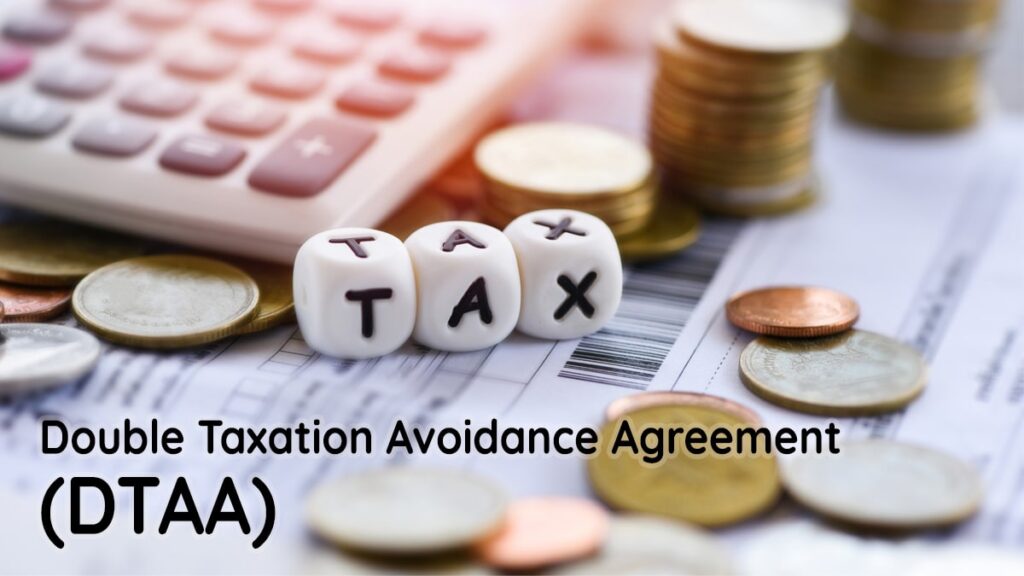Double Taxation Avoidance Agreement (DTAA) is an agreement that India has signed with other countries to ensure that the resident of India working outside do not have to pay taxes twice.
Earlier the system of taxation was such that the NRI working in some other country will have to pay income taxes on the resident country as well as India.
This puts pressure on the individual working and leads to a lot of tax theft. So, to resolve this issue India along with 88 other countries signed a treaty that governs how a person residing outside a country will be taxed by the home country as well as the resident country.
This article will cover what is Double Taxation Avoidance Agreement, a list of countries with whom India signed this treaty, and much more.

Table of Contents
What is Double Taxation Avoidance Agreement (DTAA)?
Double Taxation Avoidance Agreement is a taxation agreement or Treaty which is between two or more countries for the taxation of an individual who has income from both of these countries.
Promotion of international trade is very important to ensure a free and fair development across the world and to do that a system of taxation with a mutual benefit system is required.
United National Tax committee modeled a comprehensive convention called the UN model tax convention which all the DTAA is based on.
This is done to promote cross-border economic activity and a seamless transfer of technology to increase trade and commerce.
When there was no DTAA, the income earned by the individual would be calculated as a whole which leads to double taxation.
This double taxation would lead to the individual being the loss due to which organizations like UN Tax Committee and various subcommunities engage in treaties.
Types of DTAA
There are several types of DTAA that India has signed with other countries, which are as follows-
Comprehensive Agreement
A comprehensive Agreement is an agreement that governs the entirety of the structure of taxation between two countries.
Limited Multilateral Agreement
Limited Multilateral Agreement is a type of DTAA that only covers certain sectors and incomes earned by individuals in certain sectors of both countries.
Tax Information Exchange Agreement
It is an agreement where both the signatories will exchange tax information filed by the individual in their resident country and home country. This ensures that no tax evasion can be done by the individual.
List of Countries with India signed DTAA Treaty (DTAA Rates)
The following are list of countries with whom India has signed the DTAA Treaty is as follows-
| COUNTRY | DTAA TYPE | DTAA TDS RATES | |
| Afghanistan | Limited Agreement | – | |
| Albania | Comprehensive Agreement | 10% | |
| Argentina | Tax Information Exchange Agreement | – | |
| Armenia | Comprehensive Agreement | 10% | |
| Australia | Comprehensive Agreement | 15% | |
| Austria | Comprehensive Agreement | 10% | |
| Bahamas | Tax Information Exchange Agreement | – | |
| Bahrain | Tax Information Exchange Agreement | – | |
| Bangladesh | Comprehensive Agreement Limited Multilateral Agreement | 10% | |
| Belarus | Comprehensive Agreement | 10% | |
| Belgium | Comprehensive Agreement | 15% | |
| Belize | Tax Information Exchange Agreement | – | |
| Bermuda | Tax Information Exchange Agreement | – | |
| Bhutan | Comprehensive Agreement Limited Multilateral Agreement | 10% | |
| Botswana | Comprehensive Agreement | 10% | |
| Brazil | Comprehensive Agreement | 15% | |
| British Virgin Islands | Tax Information Exchange Agreement | – | |
| Bulgaria | Comprehensive Agreement | 15% | |
| Canada | Comprehensive Agreement | 15% | |
| Cayman Islands | Tax Information Exchange Agreement | – | |
| China | Comprehensive Agreement | 15% | |
| Columbia | Comprehensive Agreement | – | |
| Croatia | Comprehensive Agreement | 5% | |
| Cyprus | Comprehensive Agreement | 10% | |
| Czech Republic | Comprehensive Agreement | 10% | |
| Denmark | Comprehensive Agreement | 15% | |
| Egypt | Comprehensive Agreement | 10% | |
| Estonia | Comprehensive Agreement | 10% | |
| Ethiopia | Limited AgreementComprehensive Agreement | 10% | |
| Fiji | Comprehensive Agreement | 5% | |
| Finland | Comprehensive Agreement | 10% | |
| France | Comprehensive Agreement | 10% | |
| Georgia | Comprehensive Agreement | 10% | |
| Germany | Comprehensive Agreement | 10% | |
| Greece | Comprehensive Agreement | 20% | |
| Guernsey | Tax Information Exchange Agreement | – | |
| Hashemite Kingdom of Jordan | Comprehensive Agreement | 10% | |
| Hong Kong | Comprehensive Agreement | – | |
| Hungary | Comprehensive Agreement | 10% | |
| Iceland | Comprehensive Agreement | 10% | |
| Indonesia | Comprehensive Agreement | 10% | |
| Iran | Limited Agreement | 10% | |
| Ireland | Comprehensive Agreement | 10% | |
| Isle of Man | Tax Information Exchange Agreement | – | |
| Israel | Comprehensive Agreement | 10% | |
| Italy | Comprehensive Agreement | 15% | |
| Japan | Comprehensive Agreement | 10% | |
| Kazakhstan | Comprehensive Agreement | 10% | |
| Kenya | Comprehensive Agreement | 15% | |
| Kuwait | Comprehensive Agreement | 10% | |
| Kyrgyz Republic | Comprehensive Agreement | 10% | |
| Latvia | Comprehensive Agreement | 10% | |
| Lebanon | Limited Agreement | – | |
| Liberia | Tax Information Exchange Agreement | – | |
| Libya | Comprehensive Agreement | 20% | |
| Lithuania | Comprehensive Agreement | 10% | |
| Luxembourg | Comprehensive Agreement | 10% | |
| Macedonia | Comprehensive Agreement | 10% | |
| Malaysia | Comprehensive Agreement | 10% | |
| Maldives | Tax Information Exchange Agreement Limited Multilateral Agreement | – | |
| Malta | Comprehensive Agreement | 10% | |
| Mauritius | Comprehensive Agreement | 7.50-10% | |
| Mongolia | Comprehensive Agreement | 15% | |
| Montenegro | Comprehensive Agreement | 10% | |
| Morocco | Comprehensive Agreement | 10% | |
| Mozambique | Comprehensive Agreement | 10% | |
| Myanmar | Comprehensive Agreement | 10% | |
| Namibia | Comprehensive Agreement | 10% | |
| Nepal | Comprehensive Agreement Limited Multilateral Agreement | 15% | |
| Netherland | Comprehensive Agreement | 10% | |
| New Zealand | Comprehensive Agreement | 10% | |
| Norway | Comprehensive Agreement | 15% | |
| Oman | Comprehensive Agreement | 10% | |
| Pakistan | Limited Multilateral Agreement | – | |
| People’s Democratic Republic of Yemen | Limited Agreement | – | |
| Philippines | Comprehensive Agreement | 15% | |
| Poland | Comprehensive Agreement | 15% | |
| Portuguese Republic | Comprehensive Agreement | 10% | |
| Principality of Liechtenstein | Tax Information Exchange Agreement | – | |
| Principality of Monaco | Tax Information Exchange Agreement | – | |
| Qatar | Comprehensive Agreement | 10% | |
| Romania | Comprehensive Agreement | 15% | |
| Russia | Comprehensive Agreement | 10% | |
| Saint Kitts and Nevis | Tax Information Exchange Agreement | ||
| Saudi Arabia | Comprehensive Agreement | 10% | |
| Serbia | Comprehensive Agreement | 5% | |
| Seychelles | Tax Information Exchange Agreement | – | |
| Singapore | Comprehensive Agreement | 15% | |
| Slovak Republic | Comprehensive Agreement | – | |
| Slovenia | Comprehensive Agreement | 5% | |
| South Africa | Comprehensive Agreement | 10% | |
| South Korea | Comprehensive Agreement | 15% | |
| Spain | Comprehensive Agreement | 15% | |
| Sri Lanka | Comprehensive Agreement Limited Multilateral Agreement | 7.50% | |
| Sudan | Comprehensive Agreement | 10% | |
| Sweden | Comprehensive Agreement | 10% | |
| Swiss Confederation | Comprehensive Agreement | 10% | |
| Syrian Arab Republic | Comprehensive Agreement | 7.50% | |
| Taipei | Specified Associations Agreement | 12.50% | |
| Tajikistan | Comprehensive Agreement | 10% | |
| Tanzania | Comprehensive Agreement | 12.50% | |
| Thailand | Comprehensive Agreement | 25% | |
| Trinidad and Tobago | Comprehensive Agreement | 10% | |
| Turkey | Comprehensive Agreement | 15% | |
| Turkmenistan | Comprehensive Agreement | 10% | |
| United Arab Emirates | Comprehensive Agreement | 12.50% | |
| Uganda | Comprehensive Agreement | 10% | |
| Ukraine | Comprehensive Agreement | 10% | |
| United Kingdom | Comprehensive Agreement | 15% | |
| United Mexican States | Comprehensive Agreement | 10% | |
| United States of America | Comprehensive Agreement | 15% | |
| Uzbekistan | Comprehensive Agreement | 15% | |
| Vietnam | Comprehensive Agreement | 10% | |
| Zambia | Comprehensive Agreement | 10% | |
Benefits of Double Taxation Avoidance Agreement (DTAA)
There are several benefits that both countries get out of a well-structured and mutually beneficial DTAA agreement. The following are the benefits that Double Taxation Avoidance Agreement (DTAA) has-
- The individual working in the country with citizenship of India will be benefitted from a concession on the tax that he/she has to pay
- Both countries will have an attractive foreign investment opportunity amongst each other
- A certainty for the individuals in question about their international income and the tax imposed on it
- The agreement also ensures that the tax benefit is only offered to the genuine candidate by mandating an anti-abusive provision
Documents required to avail of the benefits under DTAA
To avail benefit from the provision under the DTAA, an individual must provide the following document to the Income Tax authorities-s
- Self-declaration cum indemnity format
- Self-attested PAN card copy
- Self-attested visa and passport copy
- PIO proof copy (if applicable)
- Tax Residency Certificate (TRC)
The Finance Act 2013, mandates the individual in question to produce his/her Tax Residency Certificate.
FAQ
Article 12 of DTAA between the US and India talks about the Royalties and Fees and the tax to be charged to the individuals with the royalty fee as their income. The taxation of the royalty & fee will be 15-20% charged by the other state where the tax is applicable.
Article 25 of the DTAA extensively talks about the relief that the DTAA provides against Double Taxation. This article, clearly mentions areas where both states will share the tax revenue and where one of them will get their share.
DTAA Stands for Double Taxation Avoidance Agreement which is a tax agreement where the individuals living outside country A and earning some revenue from country A will be taxed in country B where they are living.
In case there is no DTAA between the two countries then the individual will have to pay taxes even on the income earned from his/her resident country to his home county and vice versa is also true which makes his/her pay double tax.
I’m Shiv Kumar, a graduate with a passion for finance, marketing, and technology. My journey into finance started with a desire to understand money management and investing.
Our main goal is to empower individuals through financial education. We believe that everyone should have the opportunity to build a strong financial foundation. Whether you’re a seasoned investor or just getting started, we provide articles, guides, and resources to help you navigate the financial landscape.
I invite you to join our community of financially savvy individuals. Feel free to ask questions, engage with our content, and explore the topics that matter to you. Together, let’s take control of our financial futures.




